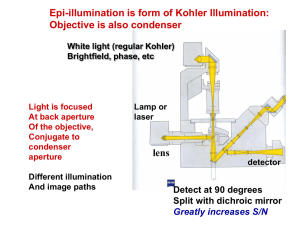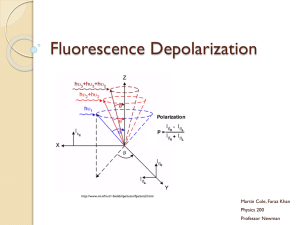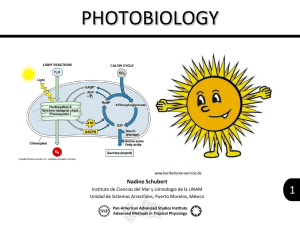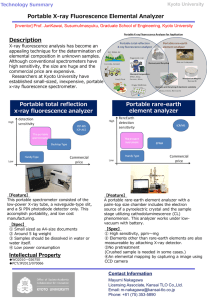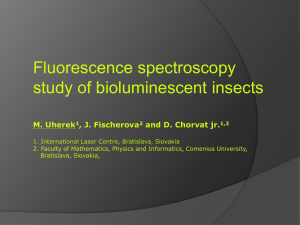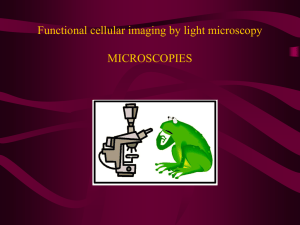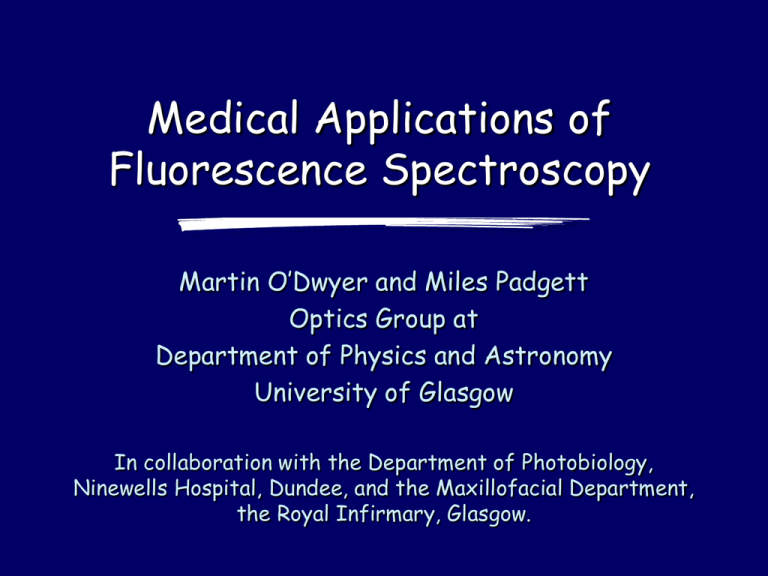
Medical Applications of
Fluorescence Spectroscopy
Martin O’Dwyer and Miles Padgett
Optics Group at
Department of Physics and Astronomy
University of Glasgow
In collaboration with the Department of Photobiology,
Ninewells Hospital, Dundee, and the Maxillofacial Department,
the Royal Infirmary, Glasgow.
This talk
History of the project
The fluorescence systems we’ve used
Some work we’ve done
– Older examples briefly
– Recent example in more detail
Acknowledgements
Detection of tissue fluorescence (why?)
Tissue fluorescence
Autofluorescence:
reduced in cancers
Photosensitiser-induced
fluorescence: highlights cancers
Fluorescence detection
Lifetime analysis
Spectral analysis
Fluorescence
imaging
Fluorescence
spectroscopy
(optical biopsy)
5-aminolaevulinic acid (ALA)
Aminolaevulinic acid (ALA) administered to patient
Build-up of protoporphyrin IX (PpIX) in lesion
Illumination of tissue
Dual-peaked
fluorescence at
635 and 700nm:
Fluorescence
detection
Selective destruction
of lesion:
Photodynamic
therapy (PDT)
Gradual PpIX
photobleaching
limits PDT and
causes fluorescence
decrease
Tissue Fluorescence
120
AutoFluorescence
100
PpIX Fluorescence
80
60
Photoproducts
40
20
0
400
500
600
700
Fluorescence imaging system
635nm blocking
filter
635nm pass
filter
Mercury lamp
Beamsplitter
Intensified
camera
Colour
camera
Endoscope with
high transmission
at 405nm
(Karl Storz)
Imaging results (In vivo - colon cancer)
Point Application
A Compact Fluorescence System
Monitoring PDT of anal intraepithelial neoplasia
(AIN):
au to fluo rescen ce p eak
In ten sity (no rm alised to
14
12
10
8
t= 0 s
t= 1 0 0 s
PpIX
fluorescence
t= 4 0 0 s
t= 1 0 0 0 s
6
4
2
A u to flu o re sc e n c e
0
425 450 475 500 525 550 575 600 625 650 675 700 725
W av elen g th (n m )
Clear decrease in PpIX fluorescence during treatment due to
photobleaching.
Potential for determining appropriate length of treatment.
Finished System
Distinguishes between
normal and cancerous
fluorescence.
Compact, portable, robust
and user-friendly system.
Fibre-coupled for
endoscopic use.
Low cost and easily
maintained
Some Applications
Monitoring PDT of anal
intraepithelial neoplasia
Endoscopic detection of
gastrointestinal (GI) cancers
Characterisation of new
formulations in-vivo
In-vitro study of new drug
Optimise procedures
Study effects of modifying
treatment
combinations
Photodynamic Therapy
PDT now routinely used
Mostly involved in topical dermatology
Topical PDT increasingly used
Other diseases also treated
Veterinary PDT
Device used at VETSUISSE Faculty, Zurich
New Liposomal formulations of m-THPC (photosensitizer)
Fluorescent measurements to assess pharmacokinetics
F lu o re s c e n c e In te n s ity (A .U .)
New Formulations
500
tu m o r
400
s k in
300
200
100
0
1
6
11
16
21
26
31
36
41
46
T im e a fte r in je c tio n (h )
51
56
61
66
71
New
liposomal
formulation
of
the
well-known
photosensitizer Foscan (mTHPC, Temoporfin)
In-vivo measurements in cats with spontaneousely occuring
squamous cell carcinoma
Concentration: 1.5 mg Temoporfin/ml Fospeg
Drug dosage: 0.15 mg/kg; 10 J/cm2
A Patient/Volunteer
Feline squamous cell carcinoma
A
B
17 year old neutered tom
A - Before treatment
B - 3 weeks after, central necrosis of the tumour
C - 15 weeks after, complete destruction of tumour
C
Biopsy
False negative rates
Inadequacies of sampling
Inadequacies of slide preparation
Processing problems - 90% of all slides are normal; easy to miss the
comparatively rare abnormal slide.
Unnecessary costly procedures
Inability to detect the earliest signs
Optical techniques may be as effective?
Endoscopic inspection of Oral/Oesophageal cancers
autofluorescence peak)
Intensity (normalised to
25
20
15
Normal oesophageal tissue
Pre-malignant Barretts
Oesophagus
PpIX
fluorescence
10
5
Autofluorescence
0
425 450 475 500 525 550 575 600 625 650 675 700 725
Wavelength (nm)
Ratio of autofluorescence and PpIX fluorescence peaks allows
normal and pre-cancerous tissue to be clearly distinguished.
Potential for use in early detection of GI cancers.
Oral detection
Why
Rising UK incidence of oral cancer especially in Scotland
Early diagnosis is difficult
Hence Poor Prognosis
A Tool to aid the early diagnosis of cancer would be useful
Pilot study to explore a fluorescence technique to identify
suspicious tissue
Procedure
Fluorescence spectra were recorded from all
regions at 30min, 60min and 90min after
mouthwash
PpIX fluorescence levels were greater at 60 and
90mins than at 30min (as expected)
12 standard points were looked at after 90mins
In-vivo fluorescence measurements
(Six patients and six healthy volunteers)
A u to flu o resc en ce (A .U )
3
2.5
2
Contr ol- 1
Contr ol- 2
Contr ol- 3
Contr ol- 4
Contr ol- 5
Contr ol- 6
Patient- 1
Patient- 2
Patient- 3
Patient- 4
Patient- 5
Patient- 6
1.5
1
0.5
0
0
50
100
150
P e a k In te n sity (A .U )
Plot of maximum values of autofluorescence vs PpIX fluorescence
(dosage: 20mg/kg bw))
In-vivo fluorescence measurements
(Six patients and six healthy volunteers)
A u to flu o re sc en ce (A .U )
3
2.5
2
Contr ol- 1
Contr ol- 2
Contr ol- 3
Contr ol- 4
Contr ol- 5
Contr ol- 6
Patient- 1
Patient- 2
Patient- 3
Patient- 4
Patient- 5
Patient- 6
1.5
1
0.5
0
0
50
100
150
P e a k In te n sity (A .U )
Patient 1: mild and severe dysplasia..
Patient 2: Well differentiated
squamous
cell
carcinoma
with
marked lichenoid reaction.
Patient
3:
Ulceration,
severe
dysplasia adjacent to biopsy site.
Moderate dysplasia extending to
excision margin.
Patient 4: Severe dysplasia and
hyperkeratosis. The reading from
FEMS was carried out after excision
of the lesion.
Patient 5: chronic inflammation with
reactive
epithelial
changes,
diagnosed as chronic hyperplastic
candidiasis.
Patient 6: Squamous carcinoma that
had been resected from the right
floor of mouth. PDD carried out at 3
months subsequently.
PCA
Data reduction technique
Determine covariance between dimensions of data set
Principle components are eigenvectors of covariance matrix
Eigenvector with the highest eigenvalue contains the most
information about the original data set
Attractive way of processing large amounts of data
PCA
Devation in PC2 .
6
3
0
-8
Control 1
Control 3
Control 5
Patient 1
Patient 3
Patient 5
99% conf
Control 2
Control 4
Control 6
Patient 2
Patient 4
Patient 6
-1
-3
Deviation in PC1
6
Endoscopic inspection of Oral/Oesophageal cancers
Barrett’s Oesophagus Patients
Glasgow has the highest incidence in
the UK
Royal Infirmary
ALA administered orally (dosage
20mg/kg bw).
Fluorescence spectra measured
during routine endoscopy from
various tissue types.
Oral/Oesophageal parallel measurements
Optical measurement at same point
at biopsy
Hope to show definitive correlation
optical-histological
Want to know how progressed cancer
is
Prompt early biopsy
Help triage urgency of biopsy
Indicate Site to biopsy (if large
lesion)
Future work
Correlation study ongoing
Hope
to
show
definitive
correlation optical-histological
Just completed PoC project
Lifetime measurement
MHRA approval for trial
Recap
History of the project
The systems used
Some results
Future plans
Thanks to
Miles Padgett
Graham Ogden, Stuart McLaren, Carol Goodman
Julia Buchholtz
Jacqueline Hewett & Valerie Nadeau
EPSRC, Scottish Enterprise, Royal Society of Edinburgh
Jo-Etienne Abela, Robert Stuart


